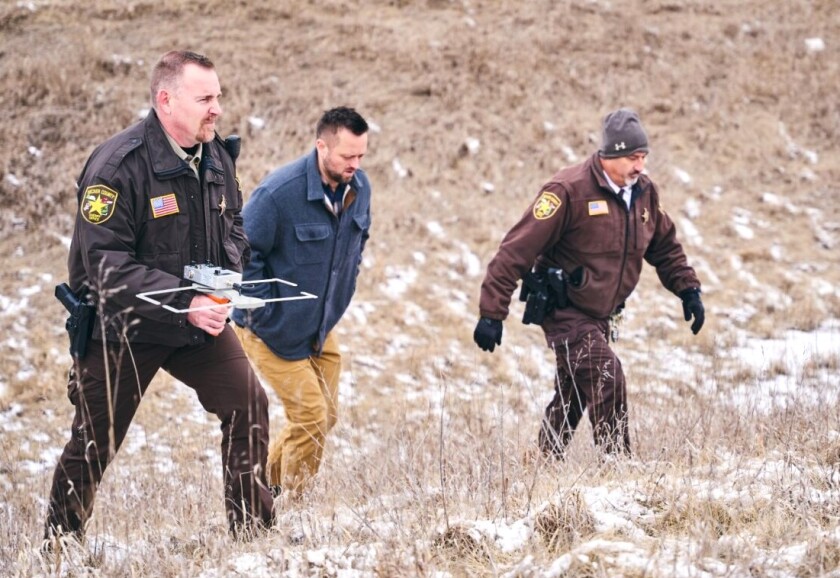DETROIT LAKES — Thanks to over $10,000 in community donations, the Becker County Sheriff’s Office is well on its way toward launching a program to help find people who have wandered off and can’t find their way home.
Project Lifesaver is designed to help vulnerable adults and children through a radio frequency tracking system, said Becker County Sheriff Todd Glander.
“All of the funds for the project came through donations,” he said, thanking all the individuals and businesses who have helped so far.
A variety of people may qualify to wear a bracelet transmitter, but most fall into three broad categories: kids on the autism spectrum, people with Alzheimer's disease and other types of dementia, and people with Down syndrome, according to Becker County Chief Deputy Shane Richard.
“It’s for those who are confused and wandering due to a cognitive condition,” he said.
ADVERTISEMENT
Such wandering behavior can be life-threatening, and the Project Lifesaver tracking equipment is designed to help law enforcement and others find the missing person as soon as possible, he said.

“The search times for certified Project Lifesaver agencies have been reduced from hours, potentially days, down to minutes,” according to the program’s national website. “Recovery times for Project Lifesaver agencies average 30 minutes, which is 95% less time than standard operations without Project Lifesaver.”
Officers use hand-held receivers that “chirp” louder as they get closer to the missing person wearing the transmitting bracelet. The effective range is a mile to a half-mile, depending on terrain.
By standing in one place and turning in a full circle, an officer can tell the best direction to search.
Each bracelet is tuned to transmit a specific radio frequency, so trackers aren’t thrown off by someone else nearby who is also wearing one of the bracelets.
The Project Lifesaver program trains officers to use the tracking equipment and on search and rescue methods. Nine Becker County officers were trained recently by Wood County, Wisconsin, Deputy Sara McCormick, and those nine will train their fellow officers. As the program grows, they will likely train others, too, including firefighters, Richard said.
Batteries on the bracelet transmitters need to be changed every 60 days, and that work will also be done by sheriff’s officers.
Everybody’s different, but some people with cognitive disabilities are afraid of noise and bright lights and actually hide from people searching for them, causing searchers to miss them in tall grass or swampy areas when they otherwise wouldn’t, Richard said.
ADVERTISEMENT

There’s a chance that something like that happened in the past in Becker County. Four years ago, an autistic Round Lake teen wandered from his home about midnight and could not be found — he spent the night outside, with the temperature around freezing, with officers from multiple agencies searching for him, Glander said.
In the morning, at about 9 a.m., he walked out of the marshy area where he had spent the night. Volunteer firefighters had walked that same area. “They could have walked right past him,” Glander said. If the boy had been equipped with an Project Lifesaver transmitter, he would have been found much sooner.
Having officers meet with clients every 60 days for a battery change will help people get to know each other, and may help fearful clients become more comfortable around law enforcement officers.
“One of the benefits is this program gives people the ability to have rapport with officers — the badge, the uniform — they look at the officer as a friend they can go to, lets them know they’re one of the good guys, you can go to them,” Richard said.
“Each case is an individual,” he added. “We meet with family (to better understand the missing person). “If they don’t like lights and sirens, we don’t respond with lights and sirens,” Richard said. “Some love lights and sirens and come running out.”
In other cases, the missing person might love something like sour cream and onion potato chips, and come along easily with an officer sharing from a chip bag.
The next step in the program for the Becker County Sheriff’s Office is to set up a local website for Project Lifesaver, onto which caregivers will be able to download photos and specifics of clients who have gone wandering, said Sheriff’s Officer Luke Swere, who will be one of the program administrators.
“We’re working on the policy, procedures and logistics that we have to go through before we totally implement it,” he said.
ADVERTISEMENT
“There are HIPAA laws involved, so we have to be careful about privacy, but we still need to be able to share information,” Richard said.
“The biggest thing is how soon the family calls and lets us know,” he added. Someone in the intermediate stage of Alzheimer’s who is in good physical shape “can walk for miles,” Richard said.
When the policies, logistics and website are nailed down, the next step will be to recruit eligible people — “people who are confused and prone to wandering,” Richard said — whose families are willing to join the program.
Then it will be one more way, along with GPS tracking systems, flying drones and other tools, to help bring a wanderer safely home.















